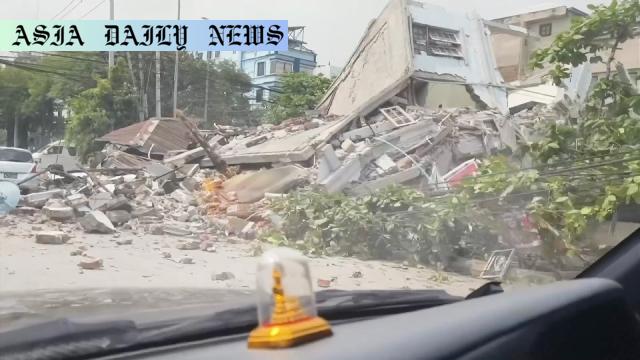Myanmar earthquake – The death toll in Myanmar’s recent magnitude 7.7 earthquake has reached 1,644, with widespread destruction reported.
- A magnitude 7.7 earthquake struck near Mandalay, Myanmar.
- The death toll has exceeded 1,600 in Myanmar.
- Thailand reported casualties and injuries in Bangkok due to the quake’s impact.

Massive Earthquake Hits Myanmar
On Friday, Myanmar was struck by a catastrophic earthquake registering a magnitude of 7.7, centered near the city of Mandalay. The impact of the quake, which occurred at a shallow depth of approximately 10 kilometers, has resulted in widespread devastation across central regions of the country. According to Myanmar’s state-run television, the number of fatalities has tragically risen to 1,644 as rescue efforts continue around the clock in hopes of recovering survivors from the debris and rubble.
The powerful earthquake was followed a mere 10 minutes later by another strong tremor of magnitude 6.7, compounding the disaster and further disrupting emergency responses. The destruction spans residential areas, infrastructure, and public buildings, leaving countless individuals homeless and in dire need of assistance. The calamity represents one of the most severe natural disasters to strike Myanmar in recent history.
Repercussions Felt in Neighboring Thailand
The impact of the earthquake was not limited to Myanmar. In neighboring Thailand, aftershocks from the quake caused a high-rise building under construction in Bangkok to collapse. The incident led to the tragic death of at least five individuals, with 17 others sustaining injuries. Rescuers in Thailand are actively searching for approximately 100 people who are feared to be trapped beneath the rubble, hoping to find survivors amid the chaos.
Thai Deputy Prime Minister Anutin Charnvirakul visited the site of the collapse to provide support and oversee rescue efforts. In light of the disaster, Thai authorities are now urging mandatory safety inspections for all public and private buildings to ensure they comply with earthquake-resistant standards, in an attempt to mitigate risks in the future.
Ongoing Challenges for Rescuers and Authorities
The aftermath of the earthquake has posed significant challenges for both Myanmar and Thai authorities. Rescue operations in Myanmar are hindered by damaged roads, limited resources, and difficult terrain, further delaying the delivery of aid to affected communities. Many individuals remain unaccounted for as emergency teams face the arduous task of removing debris while ensuring their own safety amidst the ongoing risk of aftershocks.
Both governments, along with international humanitarian organizations, are working tirelessly to provide relief supplies, from food and water to medical aid. Nonetheless, the devastation underscores the need for stronger infrastructure and preparedness for natural disasters in the region. This tragedy serves as a sobering reminder of the destructive power of nature and the importance of community resilience and emergency planning.
Global Support and Humanitarian Assistance
As news of the earthquake spreads, countries from around the world are offering support to Myanmar and Thailand. International aid organizations have pledged resources and expertise to assist in rescue and relief operations. However, the sheer scale of the destruction is expected to require months, if not years, of recovery efforts to rebuild the affected areas and support displaced populations.
Among the priorities for global assistance are ensuring safe shelter for survivors, rebuilding essential infrastructure, and providing psychological support to those who have experienced significant trauma from the disaster. This coordinated effort reflects the global community’s commitment to standing with Myanmar and Thailand as they recover from this devastating event.



Commentary
The Fragility of Human Existence
The recent earthquake in Myanmar serves as a grim reminder of the fragility of human existence in the face of nature’s raw power. Within moments, lives are irrevocably changed, families torn apart, and communities left scrambling to recover from the devastation. While humanity has made significant advancements in technology and engineering, natural disasters like this highlight the vulnerabilities that still remain, emphasizing the importance of preparedness and resilience.
The Role of Infrastructure and Planning
One of the key takeaways from this tragedy is the critical need for improved infrastructure and urban planning in disaster-prone regions. Myanmar, like many developing nations, often struggles with limited resources, which poses challenges in constructing earthquake-resistant buildings. Thailand’s building collapse further underscores the necessity for stringent safety regulations and regular inspections to prevent such loss of life in the future. Strengthening infrastructure and incorporating disaster-resilient designs should be a top priority for governments across the region.
Global Solidarity in Times of Crisis
The global response to this disaster has been heartening, with aid agencies and countries stepping forward to provide support. Moments of such collective solidarity demonstrate that even amidst tragedy, humanity’s capacity for empathy and cooperation remains strong. These efforts not only aid recovery but also serve as a testament to the interconnectedness of the global community. It is essential, however, that this support extends beyond immediate relief, focusing on sustainable recovery and long-term resilience in disaster-stricken areas.
In closing, the Myanmar earthquake is a tragic event that calls for reflection and action. From improving regional disaster preparedness to fostering international collaboration, there is much to be learned and done in the wake of such a calamity. The resilience of the affected communities, combined with global support, will undoubtedly pave the way for recovery and healing in the months and years ahead.